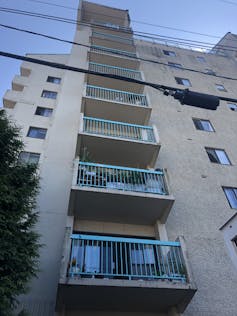
There is growing concern about people’s unwillingness to get to know their neighbours. This concern is significant enough to have spurred research into what has been termed the “emerging asocial society” — one of the challenge areas of an initiative called Imagining Canada’s Future.
To contribute to this challenge, our research examines what we do and do not know about neighbours in densifying Canadian cities.
Over the past three years, we have partnered with community housing providers seeking to improve resident quality of life in challenging conditions of change. Understanding whether residents are willing to get to know their neighbours is an important initial step.
The more willing people are to make ties, the better the prospects are for building social interactions into mutual feelings of trust, welcome and belonging in urban neighbourhoods. These feelings are linked to a number of positive impacts, including physical and mental health, voluntarism and participation, cost-effectiveness of urban planning and safety.
We specifically used the question “would you like to get to know your neighbours better?” to assess neighbour willingness. Comparing our results over the past three years suggests that concerns about the decline of neighbouring are not unfounded: growing numbers of people are not seeking to deepen their neighbourly ties.
Rather than sound the alarm about anti-social communities, we argue that the situation is more complex. Before we draw conclusions about the implications of social isolation, we should check our expectations of how, when and why neighbouring does or does not happen.
Many of the classical assumptions of neighbouring may not apply today. By the same token, we can’t expect old fashioned emblems of what neighbourly communities look like — think of the Neighbourhood Watch or Block Parent programs — to fit today’s picture.
Rapidly changing demographics
Federally, provincially, and within many regional and municipal governments, efforts to increase the supply of homes in Canada are at an all-time high. A growing share of these homes are in high-density buildings.
At the same time, the demographic composition of fast-growing neighbourhoods is changing. Canada set immigration records in 2022 and 2023, leading to changes in both the population and living environments of our cities.
When we scanned the research literature to understand what these changes might mean for the social dynamics of urban communities, and how to support neighbouring in this new context, we found very limited research about the kind of neighbours that high density and high social mix make, in Canada. Our research aims to fill this gap.
Our research focuses on the social aspects of urban life for residents of community housing, an umbrella term for non-market and non-profit housing that is home to many of those classified as vulnerable by the National Housing Strategy.
Through resident surveys and other methods like focus groups and photovoice, we seek the perceptions and experiences of neighbouring within contexts of rapid change that often involve poverty, immigration, social exclusion, resident turnover and eviction, and bias related to age, race, Indigeneity and other factors.
Our research demonstrates there are valid reasons for the ambivalence many people feel about their neighbours. Community housing residents may be prone to higher risks of conflict with higher stakes for their housing security and mental and physical health.
When people’s housing is unstable, inadequate, unaffordable and doesn’t provide access to the amenities and resources they need, they may be less likely to have the sense of welcome, belonging and trust to engage in neighbouring behaviour. This can result in less interest and less capability to be a good neighbour, classically understood.
At the same time, neighbouring remains possible and important in community housing. Our research shows the important role neighbouring plays in neighbourhood quality of life.
Neighbouring is a spectrum
In our focus group research conducted in Vancouver, we discovered that it makes more sense to consider neighbouring not as good versus bad but as a spectrum of different behaviours in challenging contexts.

Residents of community housing experience neighbouring in ways that run the gamut from pro-social to anti-social, with a significant middle zone of asocial activities and relationships. Rather than associating certain behaviours with bad or good neighbours, different contexts and dimensions of vulnerability can determine where a behaviour falls on the neighbour spectrum.
Our focus group participants defined good neighbours as residents who understood the importance of social recognition, respect for difference and need for privacy, offering help, and opportunities for shared social activities.
In the middle zone, we found asocial neighbouring activities that defied categorization. Depending on the circumstances, these activities could be the source of conflict or a path to generate a more pro-social sense of neighbouring. Activities included mutual aid; sharing food; noise and odours; responding to illness and loss of life; observing rules; response to emergencies; attitudes about privacy; and organized social activities.
People who may appear disillusioned with their neighbours often still had the capacity to be good neighbours — but they struggled to be good neighbours under the weight of poverty, inequality, and the structures and regulations in place at home.
The more the participants discussed with one another and with us, the more willingness they demonstrated to improve the functional neighbourliness of their buildings. This willingness proves the potential for new programs, rules and spaces to support neighbouring within community housing. However, it also provides a warning.
New realities of neighbouring
Social connections are not a natural, synergistic outcome of living in close quarters with other people. New understandings of the spectrum of neighbouring may open up more meaningful neighbour behaviours for those facing social isolation who are most at risk from anti-social behaviours.
At the same time, making better neighbours is not always the place to start to improve quality of life in high density neighbourhoods undergoing rapid change. Neighbouring can be politically and emotionally charged. Pro-social neighbouring work should be treated with cultural and situational awareness in mind.
In the context of refugee settlement in particular, there is a need for both restraint and understanding of specific conditions and cultures before advancing social connections.
As urban and neighbourhood planning gears up to meet the demands of changing Canadian cities, we also need to consider neighbour dynamics.
We are in need of community development strategies that reflect new realities of neighbouring across a spectrum of structural and social expectations, risks and rewards. For rapidly changing neighbourhoods, with high levels of diversity and vulnerability, neighbouring carries risks and constraints, but still matters.![]()
Meg Holden, Professor, Urban Studies and Professor of Resource and Environmental Management, Simon Fraser University and Yushu Zhu, Assistant Professor, Urban Studies and Public Policy, Simon Fraser University
This article is republished from The Conversation under a Creative Commons license. Read the original article.


